Rich snippets have transformed how search results appear on major search engines, especially Google. This Rich Snippets Guide aims to provide a comprehensive overview of their significance, especially in enhancing user experience and website visibility. Webmasters can ensure their content stands out in search results by understanding the intricacies of Google-rich snippets and leveraging the rich snippet testing tool. Additionally, with tools like the rich snippets testing tool, one can validate and optimize the markup for the best results. As we delve deeper, the role of rich snippets SEO strategies will become evident, highlighting the undeniable influence of rich snippets in modern search engine optimization.
What Are Rich Snippets?
In the digital realm, the quest for improved user experience and relevant search results has led to the evolution of search results beyond the basic blue links. This is where the concept of “rich snippets” comes into play. So, what are rich snippets? Let’s delve into it.
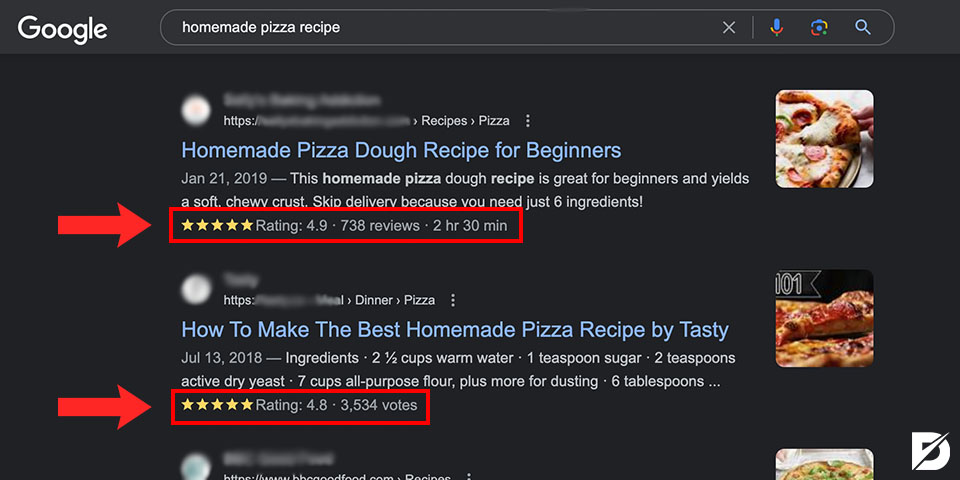
At its core, what is a rich snippet? A rich snippet is an enhanced form of search result that offers more than just the basic title, URL, and description. Instead, it provides additional data to help users decide if a particular result is relevant to their search query. This can include reviews, ratings, product prices, images, or other relevant information. To further clarify, imagine you are searching for a recipe online. Traditional search results might just provide you with links to various recipes. However, with the integration of rich snippets, these results can display ingredients, preparation time, ratings from other users, or even a photo of the finished dish. These enriched results improve website click-through rates and significantly enhance user experience, as users get a clearer preview of the content they’re about to click on.
How do Rich Snippets Work?
Google Rich Snippets are specialized information that appears in Google search results to provide quick and relevant data about a webpage’s content. These snippets are derived from structured data that website owners can include in their pages. By incorporating this structured data, website owners can enhance how their content is represented in search results.
- Structured Data: The first step in creating rich snippets is adding structured data to a webpage. Structured data is code written in a specific format, communicating the meaning behind the content to search engines. Common formats include JSON-LD, Microdata, and RDFa.
- Markup Content: Site owners use one of the above formats to mark up their content. For instance, if you have a recipe on your website, you can use structured data to specify ingredients, cooking time, calories, ratings, and more. By doing so, Google can create a rich snippet showing these details directly in the search results.
- Google’s Role: When Google’s crawlers visit a site, they pick up this structured data and, if it’s properly implemented and relevant, use it to form rich snippets in the search results.
- Search Results: Once Google has processed the structured data, the search results for that page can include the rich snippets. For example, when users search for a recipe, they might see a result with a picture of the dish, star ratings, cooking time, and calories directly in the search results.
Rich Snippets Examples
Rich Snippets Examples are as follows;
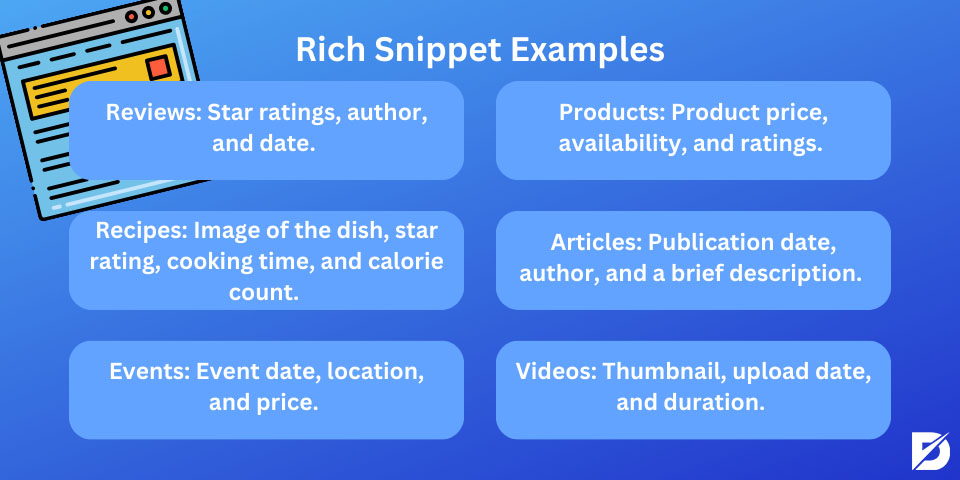
- Reviews: Star ratings, author, and date.
- Recipes: Image of the dish, star rating, cooking time, and calorie count.
- Events: Event date, location, and price.
- Products: Product price, availability, and ratings.
- Articles: Publication date, author, and a brief description.
- Videos: Thumbnail, upload date, and duration.
It’s worth noting that while incorporating structured data can make your content eligible for rich snippets, Google does not guarantee that they will show them. The decision to display rich snippets depends on various factors, including the quality and relevance of the structured data and the search query.
How to Get Rich Snippets
Getting rich snippets for your website content in search engine results pages (SERPs) can enhance your visibility and increase click-through rates. Rich snippets provide users with more detailed information about the content on a webpage, which can make it stand out in the SERPs.
Here’s a step-by-step guide on how to get rich snippets:
- Structured Data: At the core of rich snippets is structured data. Use schema markup (a form of microdata) to provide search engines with more information about the content on your website. You can find the appropriate markup for your content at Schema.org or Dopinger’s schema markup generator.
- Test Your Markup: Before publishing, checking if your structured data is implemented correctly is crucial. Google’s Rich Snippet Test or the newer “Rich Results Test” tool can help you verify your markup.
- Include Quality Content: Always ensure the content you’re marking up is of high quality and relevant to the markup. If you’re marking up a recipe, for example, the content should provide detailed information about that recipe.
- Relevant Markup: Only use schema markup for content that it directly relates to. Adding irrelevant markups to gain more visibility can be seen as spammy and can lead to penalties.
- Wait and Monitor: After adding structured data to your website, it might take some time before you notice rich snippets for your content in the SERPs. Continuously monitor your performance using tools like Google Search Console.
- Stay Updated: Search engines regularly update their guidelines for structured data. It’s essential to stay updated with these changes and adjust your markup accordingly.
- Mobile Compatibility: Ensure that your marked-up content is accessible and displays correctly on mobile devices, as search engines, especially Google, place significant emphasis on mobile compatibility.
- Check Competitors: Regularly review your competitors’ rich snippets to see any trends or changes in how structured data is displayed. This can give you insights into potential improvements for your markup.
- Avoid Shortcuts: While there are plugins and tools that can simplify the process of adding structured data, always ensure that the result is accurate and not over-optimized.
- Consistency: Ensure that the structured data on your page matches what users see. For instance, if your schema markup indicates a certain price for a product, that price should be visible to users on that page.
Securing rich snippets for your content requires a blend of correct structured data implementation, quality content, and ongoing monitoring. The effort can result in increased visibility in the SERPs and potentially higher click-through rates.
Structured Data Markup Basics
Structured data markup, often referred to as “schema markup” or simply “schema”, is a code you can add to your website’s HTML to improve the way search engines read and represent your page in SERPs (Search Engine Results Pages). It provides explicit clues about the meaning of a page to search engines.
Here are the basics of Structured Data Markup.
Why Use Structured Data?
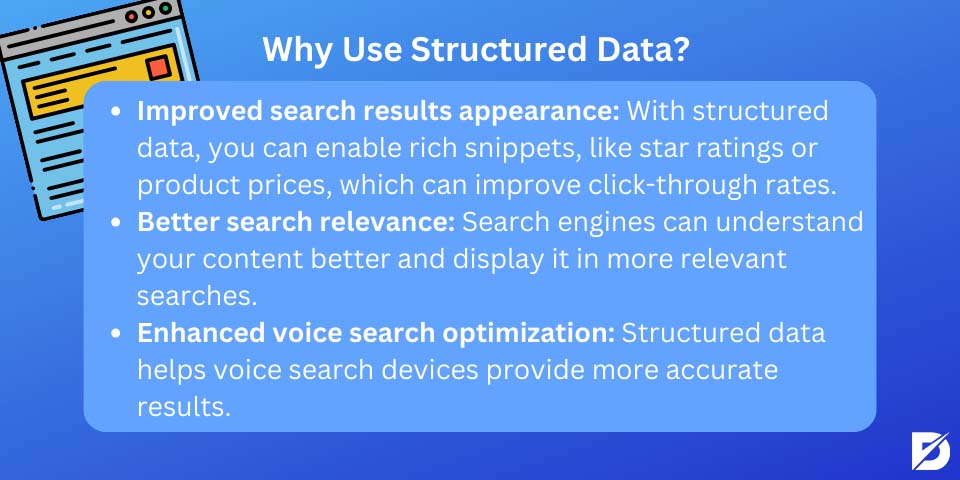
- Improved search results appearance: With structured data, you can enable rich snippets, like star ratings or product prices, which can improve click-through rates.
- Better search relevance: Search engines can understand your content better and display it in more relevant searches.
- Enhanced voice search optimization: Structured data helps voice search devices provide more accurate results.
Formats of Structured Data:
- JSON-LD: Recommended by Google, JavaScript code is encapsulated within a script tag, which can be placed in the head or body of the page.
- Microdata: A community-driven HTML standard for integrating structured data within HTML content.
- RDFa: Resource Description Framework in Attributes. It’s an extension to HTML5 and is used to markup metadata within web pages.
Vocabulary
The most common vocabulary for structured data is Schema.org. Initiated by Google, Microsoft, Yahoo, and Yandex, it’s a centralized repository for structured data markup. There are hundreds of types and properties that can be used, representing entities like Person, Product, Event, etc.
Tools
- Google’s or Dopinger’s Structured Data Testing Tool: Allows users to test and validate their structured data.

- Google’s Rich Results Test: Check your page is eligible for rich search results.
- Schema.org’s official website: For reference on various types and properties.
Implementation Steps
- Identify content type: Decide what content you want to markup (e.g., an article or a product).
- Choose a markup format: Typically, JSON-LD is recommended.
- Generate the markup: Some tools and plugins help generate the required markup.
- Add markup to your page: It should be added to the HTML of your page.
- Test the markup: Validate it using tools like Google’s Structured Data Testing Tool.
Common Use Cases
- Articles: Provide details about the author, date published, etc.
- Products & Offers: Display price, availability, reviews, and ratings.
- Events: Give details about the date, location, etc.
- Local Businesses: Include operation hours, location, reviews, etc.
- Recipes: Showcase preparation time, ratings, calories, etc.
Potential Issues & Pitfalls
- Incorrect Implementation: Always test your markup to ensure there are no mistakes.
- Outdated Markup: Structured data guidelines can change, so it’s essential to keep up with the latest best practices.
- Overuse: Only use structured data where relevant. Do not try to spam or use it unnecessarily, as it can lead to penalties.
Structured data markup is a valuable tool for webmasters looking to improve their website’s appearance in search results. By providing search engines with explicit clues about your content, you can enhance your site’s visibility and relevance to user queries. Proper implementation and regular testing are crucial for success.
Choosing Rich Snippet Types
Rich snippets are a fantastic tool Google provides to enhance the visibility of your search engine results. These snippets give web users a quick preview of the content they’re about to click on. By providing these little previews, users can decide more efficiently if a page contains the information they want. But which types of rich snippets should you use? And how can you test them?
Rich Snippets Google Introduction
Before delving into the types of rich snippets, it’s important to understand what they are. Rich snippets of Google are structured data tags that website owners can integrate into their existing HTML. This enhances the search engines’ ability to comprehend each webpage’s content. The bonus? Google then uses this data to improve and enhance the appearance of your site’s listings in search results.
Google Rich Snippets Testing Tool
Now, after you’ve chosen a rich snippet example type and added the necessary structured data markup to your site, how can you be sure it’s working? Enter the Google Rich Snippets Testing Tool. This invaluable tool lets you input a URL from your website or paste in code to see if your rich snippets are correctly implemented. If any errors or improvements need to be made, this tool will let you know. It’s a must-use for anyone serious about improving their site’s search engine visibility.
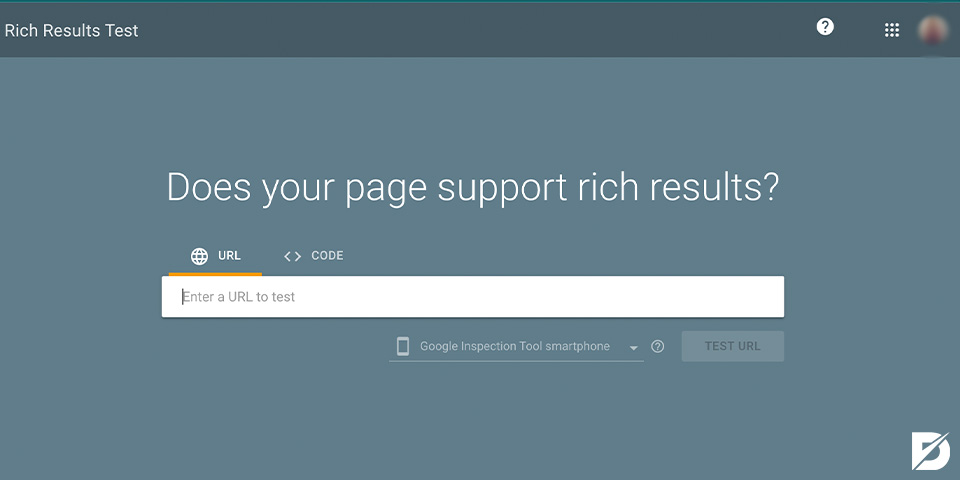
Utilizing rich snippets can significantly enhance the visibility and attractiveness of your website’s listing on search engines. Whether you’re showcasing reviews, recipes, products, or more, there’s likely a rich snippet perfect for your content. Always remember to validate your structured data with the Google Rich Snippets Testing Tool to ensure you’re getting the most out of your SEO efforts.
Implementing Schema.org Markup
Implementing Schema.org markup is a way to provide search engines with additional structured data about the content of your website. Doing so gives search engines a better understanding of your content, which can lead to improved search result displays and potentially enhanced SEO.
Here’s a step-by-step guide to implementing Schema.org markup:
- Determine What Type of Content You Have: Begin by identifying the type of content on your site that you want to enhance with schema markup. Is it a product, recipe, event, article, or something else? Schema.org has a wide range of schemas to cater to different content types.
- Choose the Relevant Schema: Once you’ve identified the type of content, visit the Schema.org website and navigate through the hierarchies to find the best schema for your content.
- Use a Markup Format: Schema.org supports different markup formats:
- Microdata
- RDFa
- JSON-LD (recommended by Google)
For this guide, we’ll use JSON-LD, the most straightforward and widely recommended format.
Using JSON-LD for Rich Snippets
- Write the Markup: Based on the chosen schema, write the JSON-LD script. Here’s a simple example for an article:
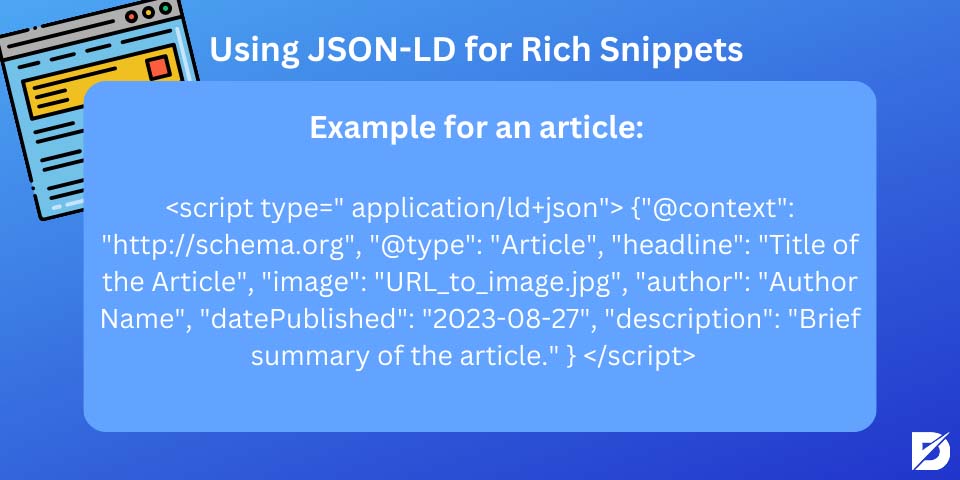
jsonCopy code
<script type=” application/ld+json”> {“@context”: “http://schema.org”, “@type”: “Article”, “headline”: “Title of the Article”, “image”: “URL_to_image.jpg”, “author”: “Author Name”, “datePublished”: “2023-08-27”, “description”: “Brief summary of the article.” } </script>
- Add the Markup to Your Page: Paste the JSON-LD script into the HTML of the page where the content resides, preferably within the <head> section. If you’re using a CMS like WordPress, there are plugins available that can help automate and simplify this process.
- Test Your Markup: Once you’ve added the markup, validate it using Google’s Rich Results Test tool. This tool will notify you of errors or suggestions to improve the markup.
- Monitor the Results: After implementing the markup and ensuring there are no errors, it might take some time for search engines to reflect these changes in the search results. Monitor your results and web traffic to see the impact.
- Stay Updated: Schema.org is an evolving vocabulary. Monitoring updates and changes that might be relevant to your website is essential.
Remember, while Schema.org markup can enhance how your content is displayed in search results, it’s not a guarantee for better rankings. It’s one of many tools in your SEO arsenal that can lead to improved online visibility when combined with other best practices.
Optimizing Content for Rich Results
Optimizing content for rich results is vital because it enhances the visibility and attractiveness of your search listings in SERPs (Search Engine Results Pages). Rich results, often powered by structured data (like Schema.org markup), can include elements like star ratings, images, or event details, making your site’s listing more clickable and informative. Here’s a guide to optimize your content for such rich results:
Understand the Opportunities
Familiarize yourself with the different types of rich results available, such as:
- Featured snippets
- Rich cards (for movies, recipes, etc.)
- Breadcrumbs
- Product ratings and reviews
- Event listings
- FAQ snippets
Implement Structured Data
- Use Schema.org markup to provide search engines with a clear understanding of the content on your site. This is crucial for rich results.
- Choose the right schema type for your content. For instance, use the “Recipe” schema for recipe pages, the “Product” schema for product listings, etc.
- Use tools like Google’s Structured Data Markup Helper to assist in creating the appropriate markup.
Quality Content is King
- Even with the right structured data, the content must be high-quality, relevant, and valuable to the user.
- Make sure your content is well-researched, well-written, and original.
Optimize for Mobile
- Google uses mobile-first indexing, meaning it predominantly uses the mobile version of your content for indexing and ranking.
- Ensure your website is mobile-responsive, as many rich results are especially prevalent on mobile searches.
Utilize Multimedia
- Images, videos, and other multimedia elements can be included in rich results.
- Ensure they are high-quality, relevant, and optimized for fast loading. Include alt tags for images and use video markup for videos.
Test Your Markup
- After implementing structured data, use Google’s Rich Results Test tool to ensure there are no errors and that Google can read the markup.
- Regularly audit and update your structured data to align with Google’s guidelines and best practices.
Monitor Performance in Google Search Console
- Google Search Console provides a “Rich Results” report that lets you see how your rich results perform.
- Monitor this report to see which pages are eligible for rich results, which are getting displayed, and if there are any issues.
Stay Updated with Changes
- Google and other search engines often update their criteria for rich results.
- Monitor any changes to guidelines or new opportunities for rich results and adjust your strategy accordingly.
Encourage Reviews
- If you want to optimize for rich results with star ratings (like for products or local businesses), encourage satisfied customers to leave reviews. This can be achieved through follow-up emails or by integrating review prompts on your website.
Optimize Page Speed:
- Faster-loading pages have a better chance of ranking and can support rich results like AMP (Accelerated Mobile Pages).
While optimizing for rich results can significantly enhance how your content is presented in SERPs, it’s not a guaranteed ranking boost. However, it can improve the user experience, indirectly leading to better engagement and rankings.
Importance of Rich Snippets in SEO
The ever-evolving landscape of Search Engine Optimization (SEO) continually presents businesses and webmasters with new techniques to boost their online visibility. Among these techniques, the rich snippet tool has emerged as an essential component. But what are they, and how do they influence SEO?
Rich snippets provide a condensed preview of a page’s content on search engine results pages (SERPs). These previews can include product ratings, prices, authorship, event details, and more. They serve as a visual cue to inform users about the page’s content before clicking.
So, why are they critical for SEO?
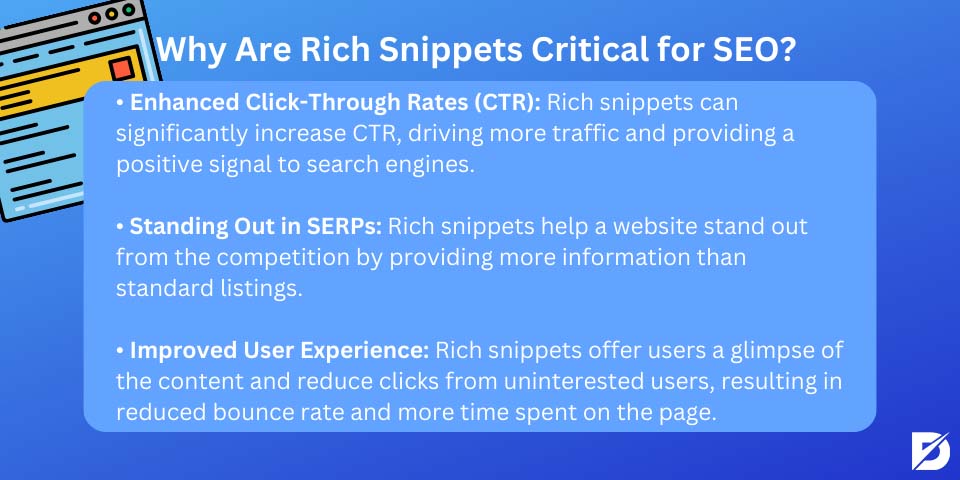
- Enhanced Click-Through Rates (CTR): Rich snippets can significantly increase a website’s CTR. When users can instantly see relevant details like star ratings or product prices, they’re more likely to click on a result. A higher CTR not only drives more traffic but is also a positive signal to search engines about the relevance and usefulness of the page.
- Standing Out in SERPs: In a sea of search results, rich snippets help a website stand out. They naturally attract users’ eyes by providing more information compared to standard listings.
- Improved User Experience: By offering users a glimpse of the content, rich snippets ensure that users know what to expect, reducing the chances of clicks from users who aren’t genuinely interested in the content. This can lead to a better on-page experience, with users spending more time on the site and bouncing less.
Do rich snippets help SEO?
Lastly, the big question: Do rich snippets help SEO? While rich snippets don’t directly influence a page’s ranking in search results, they play a pivotal role in how users interact with these results. As mentioned, they can increase CTR and improve user experience, both of which indirectly benefit SEO. As search engines, especially Google, prioritize user experience, anything that enhances this experience (like SEO-rich snippets) can potentially have a positive ripple effect on SEO. While rich snippets might seem like a small component in the vast world of SEO, their impact is significant. Implementing them correctly and ensuring they provide real value to users can give a site an edge in today’s competitive online landscape.
How to Create Rich Snippets
Before delving into how to create rich snippets, it’s essential to be familiar with the Google Rich Snippet Testing Tool (also known as the Structured Data Testing Tool). This tool allows you to check your markup to ensure it’s correctly implemented and can produce rich snippets in Google’s search results. Here are the steps to create rich snippets:
- Choose one of the Types of Content: Decide which type of content you want to mark up. Google recognizes various types of, such as articles, recipes, events, products, reviews, and more.
- Select Markup Format: The most popular format is JSON-LD, but Microdata and RDFa are also supported. Here, we’ll use JSON-LD as an example.
- Add the Markup to Your Page: Insert the structured data into the HTML of your webpage. For instance, if you have a product page, the JSON-LD might look something like this:
jsonCopy code
<script type=” application/ld+json”> {“@context”: “http://schema.org/”, “@type”: “Product”, “name”: “Your Product Name”, “image”: “URL to image”, “description”: “Short product description”, “brand”: {“@type”: “Thing”, “name”: “Your Brand Name”}, “offers”: {“@type”: “Offer”, “priceCurrency”: “USD”, “price”: “XX.00”} } </script>
- Test Your Markup: Once you’ve added the structured data to your site, use the Google Rich Snippet Testing Tool to validate your markup. This ensures there are no errors that might prevent your rich snippets from showing.
- Wait and Monitor: After implementing and validating your markup, it can take some time for Google to crawl your site and display the rich snippets in search results. Monitor your pages’ performance in Google Search Console to see if there’s any increase in click-through rates or impressions.
How to Make Rich Snippets More Effective
- Ensure the information in the markup aligns with the visible content on your page.
- Regularly update your content and markup, especially if details like prices or dates change.
- Also, don’t spam or add misleading information in your markup; this can result in penalties.
Utilizing FAQ Schema for Featured Snippets
Using the FAQ (Frequently Asked Questions) schema markup can help search engines like Google better understand the content on a webpage and potentially display it as a featured snippet or in a special way in search results. Here’s how you can utilize the FAQ schema to enhance your chances of getting a featured snippet:
- Choose the Right Content: Identify content that addresses common questions related to your product, service, or industry. Ensure that the content is clear concise, and directly answers the questions.
- Implement the FAQ Schema: Once you have your content, wrap it in the appropriate FAQPage and Question schema. Here’s an example of what this might look like in JSON-LD (a popular format for structured data):
JSON
{“@context”: “https://schema.org”, “@type”: “FAQPage”, “mainEntity”: [{“@type”: “Question”, “name”: “What is FAQ Schema?”, “acceptedAnswer”: {“@type”: “Answer”, “text”: “FAQ Schema is a type of structured data markup that helps search engines understand content in the form of frequently asked questions.”} }, {“@type”: “Question”, “name”: “How does FAQ Schema help in SEO?”, “acceptedAnswer”: {“@type”: “Answer”, “text”: “It can enhance visibility in search results by potentially appearing as a featured snippet or special result.” } }] }
- Test Your Schema: Then, after adding the FAQ schema to your webpage, use Google’s Structured Data Testing Tool or the newer Rich Results Test to verify that your markup is correctly implemented.
- Monitor Results: After implementing the FAQ schema, monitor your webpage’s performance in search results. Use tools like Google Search Console to track impressions, clicks, and positions. Remember that while schema can enhance the display of your content in SERPs, it doesn’t guarantee a featured snippet or top ranking. Quality content and SEO best practices are still crucial.
- Update Frequently: Keep your FAQ content updated. If there are new common questions or if answers change over time, update the content and the schema markup accordingly.
- Avoid Misuse: Do not use the FAQ schema for advertising purposes or content not presented in a Q&A format. Misusing schema can result in penalties or removal from search results.
- Expand to Other Schema Types: Once you’re comfortable with the FAQ schema, consider using other types of schema markup (e.g., HowTo, Product, Review) to further enhance your content’s visibility and representation in search results.
Creating Rich Snippets for Videos and Articles
Rich snippets are detailed information that appears in search results. For videos and articles, they can drastically improve click-through rates by giving users more context about the content.
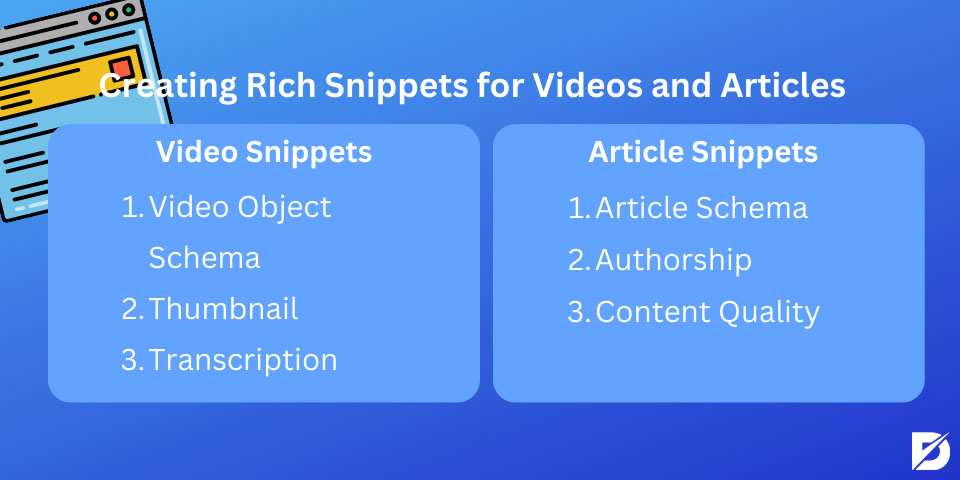
Video Snippets
- Video Object Schema: It’s essential to incorporate the VideoObject schema rich snippets into your video page. It provides search engines with relevant details like thumbnail, duration, and upload date.
- Thumbnail: Ensure your video’s thumbnail is enticing and represents the content accurately. High-quality thumbnails can improve visibility and click-through rates.
- Transcription: Adding a transcription of your video can boost SEO as it provides search engines with more text content to index.
Article Snippets
- Article Schema: This includes properties like headline, image, and publication date. There are variations, such as News Article, Blog Posting, etc., based on the content type.
- Authorship: Linking the article to an author’s profile can boost credibility and possibly visibility in search results.
- Content Quality: While rich snippets do not directly include it, search results are more likely to feature high-quality content.
Monitoring and Tracking Rich Snippet Performance
To ensure that your rich snippets are delivering the desired results:
- Google Search Console: Utilize the ‘Enhancements’ section to view the performance and possible issues related to rich snippets.
- CTR Analysis: Monitor the click-through rate for pages with rich snippets. A significant change can indicate the effectiveness of the snippet.
- Impressions: Besides CTR, also track the number of impressions. A high number of impressions with low CTR might indicate an ineffective snippet.
Troubleshooting Common Rich Snippet Issues
If your rich snippets aren’t displaying as expected:
- Missing Required Fields: Ensure all mandatory fields in the schema markup are filled out.
- Misconfigured Markup: Use tools like Google’s Structured Data Testing Tool to check for errors in the markup.
- Policy Violations: Ensure your content adheres to Google’s rich snippet guidelines.
- Delay in Crawling: Sometimes, it might take time for search engines to crawl and reflect changes. Patience is crucial.
Best Practices for Creating Effective Rich Snippets
- Relevant Content: Ensure the snippet reflects the main content of the page accurately.
- Test Regularly: Always test your schema markup to ensure it’s error-free.
- Stay Updated: Search engine guidelines and best practices can change, so regularly check for updates.
- Mobile Optimization: With the increasing number of mobile searches, ensure your rich snippets look good on mobile devices, too. You can use Dopinger’s Mobile-Friendly Test tool. Rich snippets tool options will help you!
- Avoid Misleading Information: Don’t try to trick users into clicking. Ensure that your rich snippet accurately represents your content.
Conclusion to Rich Snippets Guide
All things considered, implementing rich snippets on one’s website is a crucial step in keeping up with the modern SEO process. With this ultimate guide to rich snippets, webmasters can benefit from understanding the fundamentals of rich snippets and their importance in effective SEO. With the knowledge gained from this Rich Snippet Guide, webmasters will be able to increase website traffic by optimally utilizing their schema markup language and making them visible on search engines. So act now and start optimizing your content with rich snippets today!
Frequently Asked Questions About
Rich snippets are structured data markups added to existing HTML, allowing search engines to better understand the information on your web page and providing enhanced descriptions in search results.
While regular snippets show a page’s meta description, rich snippets provide additional data like ratings, images, or product availability, offering a more detailed view of the content’s relevance.
Directly, rich snippets do not boost a page’s position in search rankings. However, they can improve click-through rates (CTR), which indirectly can have a positive impact on rankings.
Rich snippets can be implemented using structured data markup languages like Microdata, RDFa, or JSON-LD. Tools like Google’s Structured Data Markup Helper can assist in generating the necessary code.
There can be multiple reasons: errors in your markup, not adhering to Google’s guidelines, missing mandatory fields, or simply because Google hasn’t indexed the changes yet.
Yes, there are various types, including reviews, products, recipes, events, and more. Each has its own set of properties to define specific details relevant to that content type.





No comments to show.